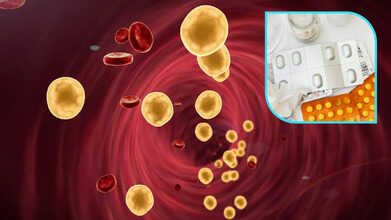- Health Conditions A-Z
- Health & Wellness
- Nutrition
- Fitness
- Health News
- Ayurveda
- Videos
- Medicine A-Z
- Parenting
Lotions, Sunscreens Linked To Hormonal Disruptions In Children: Study

Child care (Credit: Canva)
A recent study by George Mason University College of Public Health has highlighted a concerning correlation between the use of personal care products and elevated levels of phthalates in young children. Phthalates, chemicals used to increase the flexibility and durability of plastics, are also commonly found in lotions, hair oils, conditioners, and sunscreens. The study’s findings suggest these chemicals may pose potential risks to children's development during critical growth phases.
Led by Professor Michael S. Bloom, the study involved medical data from 630 children aged four to eight across ten sites in the United States. Each child underwent a clinical examination and urinalysis, while parents provided detailed information about their child’s sociodemographic background and the specific personal care products used within 24 hours before the examination.
The results revealed a significant association between the recent use of various skin care products and higher concentrations of phthalates and their replacements. Notably, the study found variations in the relationship between product use and phthalate levels based on the children’s racial and ethnic identities and sex assigned at birth. This indicates that different skin care routines may lead to different exposure levels of these endocrine-disrupting chemicals.
"The study underscores the need to understand how different personal care products contribute to endocrine-disrupting chemical exposure in children," said Bloom. "These findings can guide policy decisions and help parents make informed choices about the products they use on their children."
Natural Skin Care For Toddlers And Children
To minimize exposure to harmful chemicals, consider these natural skin care alternatives:- Gentle Cleansing: Use plain water or mild, homemade soap with natural ingredients like olive oil and coconut oil.
- Moisturizing: Apply natural oils such as coconut oil or almond oil, which are gentle and free of synthetic additives.
- Sun Protection: Dress children in protective clothing and hats, and seek shade during peak sun hours to avoid the need for chemical sunscreens.
- Bathing Frequency: Limit baths to avoid stripping natural oils from the skin; use lukewarm water and keep baths brief.
- Diet and Hydration: Maintain a balanced diet rich in fruits and vegetables and ensure adequate hydration to support healthy skin from within.
Did the Covid Vaccine Kill 10 Children? An FDA Memo Raises Troubling Questions; Here's What We Know So Far

Credits: iStock
Vaccine safety, a debate the Trump administration just cannot let go. Once again, the same debate is stirring up, and this time an internal Food and Drug Administration memo that The New York Times obtained has linked death of at least 10 children to the COVID vaccine. While the document has not been released publicly, it has already caused controversy and prompted talk of tighter regulations.
The New York Times however reports that the memo did not include essential such as the ages of the affected children, any underlying health conditions, or how the agency reached its conclusions. It also did not identify which manufacturers’ vaccines were involved. Since the findings have not been published in a peer-reviewed journal, many critics of Health Secretary Robert F. Kennedy Jr. have raised concerns about the accuracy and timing of the claims. Kennedy has long questioned the safety of Covid shots, even as scientific consensus maintains that vaccines are safe and have saved countless lives.
So, What Does The Memo Say About Vaccination And Death Of Children?
Dr Vinay Prasad, who is the head of FDA's vaccine division wrote the memo based on the findings of a review of reports that suggested that the deaths were linked to myocarditis, which is a rare inflammation of the heart muscle.
But, what does the science say? Scientists have studied the connection between Covid vaccines and myocarditis for years, especially among teenage boys and young men. Most studies have shown that the condition is rare and usually resolves quickly.
Even so, Dr Prasad wrote to staff that the memo marked the first time the FDA would acknowledge that Covid vaccines may have played a role in the deaths of American children. He indicated that he would propose several new oversight measures. It is unclear whether the White House had been briefed on these plans or how closely officials would follow them. When The New York Times reached out to Department of Health and Human Services for a comment, the request was declined.
A Shift In Vaccine Policy
This memo comes at the time when the administration has already taken a more cautious stance on vaccines. Kennedy's team has already introduced new limits on who can or cannot receive COVID shots. The shot has now been restricted to people over 65 and younger individuals with medical vulnerabilities. Officials have also called for renewed studies on long-established vaccines that have been considered safe for decades.
Public health experts from previous administrations have warned that casting doubt on vaccines could have serious consequences. Covid has killed more than a million Americans, including about 2,100 children. Experts note that many more lives were saved because vaccines became widely available.
What Are The Experts Saying?
The memo appeared just before a significant upcoming meeting of the CDC’s vaccine committee, which now includes members known for supporting the medical freedom movement. Michael Osterholm, an infectious disease specialist, said the timing did not seem accidental and called the release “irresponsible.”
Other experts expressed concern that the memo lacked important context. Dr. Paul Offit of the Children’s Hospital of Philadelphia pointed out that myocarditis from Covid infection itself has been far more severe than the rare cases linked to vaccines.
Dr. Prasad also criticized previous mandates for school and workplace vaccination, claiming they pressured people into receiving shots that might pose risks. His memo ended by addressing internal disagreements within the agency and outlining how staff should resign if they oppose the new direction.
Delhi Pollution Drops From Very Poor To Poor, Experts Say Relief Is Temporary

Credits: PTI
Delhi woke up to a slightly lower levels of AQI on Sunday Morning, November 30, as city's AQI dropped to 269 at 7am down from 305, which was recorded at 4pm on Saturday. This now falls under the "poor" category. However, experts say that the relief is temporary.
Many health experts and those who have studied the impact of pollution on humans have pointed out that anything above 300 is harmful to humans. These harms are not just limited to respiratory illnesses, and to lungs, causing lung cancers, but can also be the reason why obesity is on the rise.
Can Air Pollution Cause Obesity?
As per a 2021 study titled Effect of Air Pollution on Obesity in Children: A systematic Review and Meta-Analysis, there is a connection between air pollution and weight gain through biological behavioral mechanism. The major pollutants causing obesity are nitrous oxides, nitrogen dioxide, ozone, and particulate matter.
These could lead to systematic inflammation and metabolic disturbances, which can lead to weight gain and obesity. The study mentions that fine particulate matter [PM2.5], when it enters our body, it influences the metabolism rates.
The 2021 study also revealed that increase in air pollution, and road traffic noise was also associated with childhood obesity.
Also Read: 'Facing Breathing Issues After Morning Walk' Says CJI Surya Kant As Delhi's Toxic Air Worsens
Another 2011 study titled The influence of air pollution on cardiovascular and pulmonary function and exercise capacity: Canadian Health Measures Survey (CHMS), found that air pollutants may indirectly impact body weight by raising the risk of chronic conditions like blood pressure, heart diseases or lung diseases. "Exposure to higher concentrations of air pollution was associated with higher resting blood pressure and lower ventilatory function. Ozone was associated with reduced exercise capacity," researchers of the study wrote.
The latest study published in 2024 titled The association between air pollution and obesity: an umbrella review of meta-analyses and systematic reviews, found that air pollution can impact metabolic function by influencing inflammation in fat tissue. It leads to an increase in oxidative stress and alters one's dietary habits.
Pollution And Women's Health
This does not end here, air pollution could also negatively impact women. As Dr Anuradha Kapur, Principal Director (Obstetrics & Gynaecology) and Head of Unit, Max Smart Super Speciality Hospital, Saket says, "Environmental pollutants, such as pesticides and microplastics, can affect reproductive health and hormone regulation, potentially impacting menstrual cycles."
Dr Sonam Simpatwar, Gynaecologist with a diploma in reproductive medicine, practising at Central Railway Hospital, Mumbai further explained how pollutants impact women's health:
Endocrine Disruptors: Chemicals found in pollution, plastics, and pesticides can mimic or interfere with hormones, potentially affecting menstrual cycles.
Climate Change: Rising temperatures, extreme weather events, and changes in water quality can impact food production, nutrition, and overall health, which can indirectly affect menstrual health.
Stress: Environmental stressors, such as pollution and climate change, can lead to increased stress, which is known to influence menstrual cycles.
"It's important to note that these are potential factors, and more research is needed to fully understand their impact on menstrual health," she said.
Enlicitide: New Drug Cuts LDL Cholesterol By 60 Percent, Offers Fresh Hope For Heart Health

Credits: Canva
High levels of low-density lipoprotein cholesterol (LDL-C), commonly called "bad" cholesterol, continue to be a leading modifiable risk factor for atherosclerotic cardiovascular disease (ASCVD) worldwide. While statins and other cholesterol-lowering medications have significantly improved treatment, many patients still do not reach the LDL-C targets recommended by guidelines.
However, a new potential solution has emerged. The experimental daily oral drug called enlicitide, part of the PCSK9 inhibitor class, demonstrated in a key Phase 3 study (CORALreef Lipids) a reduction in LDL-C of about 55.8% at 24 weeks, with post-hoc analysis suggesting reductions up to 59.7% compared to a placebo.
Statins Vs Enlicitide
Statins are the standard first-line treatment for high LDL-C and have strong evidence for lowering the risk of cardiovascular events. Yet, many patients either cannot tolerate high doses or still have elevated cholesterol levels. Injectable PCSK9 inhibitors, which are monoclonal antibodies, address this gap and can lower LDL-C by up to 70% but are expensive, require injections, and have limited uptake.
Introducing an oral PCSK9 inhibitor could make powerful LDL-C reduction more accessible. According to trial data, enlicitide may achieve reductions similar to injectable options while being more convenient and potentially more widely available.
Enlicitide: A Potential Breakthrough for "Bad" Cholesterol
The CORALreef Lipids Phase 3 study involved 2,912 adults at risk of or with established ASCVD who were either already on lipid-lowering therapy or unable to take statins. Participants were randomly assigned to receive a daily 20 mg dose of oral enlicitide or a placebo. At 24 weeks, the main analysis showed an average LDL-C reduction of 55.8%, with a post-hoc reanalysis estimating 59.7%. The drug’s safety profile was similar to placebo, with no major safety concerns reported and low rates of discontinuation due to adverse effects.
Enlicitide Implications: What Does This Mean Clinically?
These reductions are substantial, suggesting oral enlicitide could:
- Improve adherence since it eliminates the need for injections
- Increase access, particularly in resource-limited areas
- Provide an alternative for patients intolerant or resistant to statins
In India, where ASCVD prevalence is high and expensive therapies are less accessible, this pill could provide a practical, scalable option alongside diet, exercise, and current statin or ezetimibe treatments.
Enlicitide Caveats: Unanswered Questions To Be Mindful Of
Despite the promising LDL-C reductions, several key issues remain:
- Cardiovascular outcomes: It is not yet confirmed whether enlicitide lowers heart attacks, strokes, or mortality. Current data focus on cholesterol reduction, not clinical endpoints.
- Long-term safety: Data beyond 24 weeks and one year is limited.
- Approval and cost: Enlicitide is still investigational and not available for regular use. Regulatory approvals, like FDA evaluation, will review full data. Its real-world adoption in India will depend on cost and accessibility.
- Patient selection and combination therapy: How enlicitide will be integrated with existing statins, ezetimibe, and lifestyle interventions is still under review. Guidelines may require updating.
- Sub-group efficacy: Will results apply across different ethnicities, comorbidities, and specifically the Indian population? Local data will be important.
The investigational oral pill enlicitide could represent a major advance in cholesterol management. For patients whose LDL-C remains high despite statins, or who cannot tolerate injections, it offers a potent and convenient alternative. Yet, medicine requires caution.
Disclaimer: This content is for general informational purposes only and is not a substitute for professional medical advice. Always consult a doctor or specialist before starting or changing any medication
© 2024 Bennett, Coleman & Company Limited

